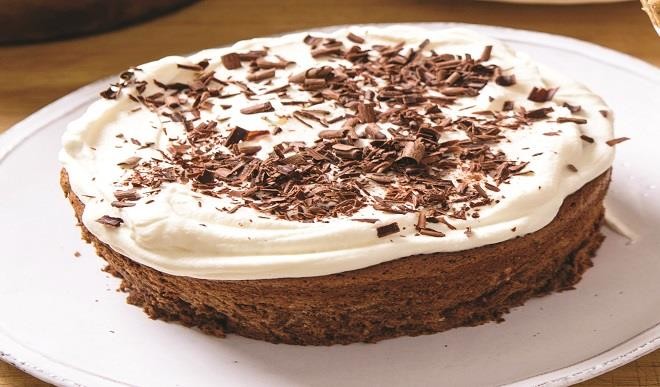
Everyone we met in Ireland told us that our trip last year couldn’t have been better timed. We were there in early summer. The countryside was at its ripest green, the characteristic clouds and rain were nowhere to be seen, and the crowds of summer tourists hadn’t yet arrived. But never mind the weather and the sights. We were there for the chocolate. Well, actually, I was there for the milk chocolate. My husband, Mahir, who proclaims his allegiance to dark, was my grumbling recruit.
Eating milk chocolate – the more ridiculously creamy, the better – is one of my ultimate sources of satisfaction. The dark kind, however, is a food world star. The news media perpetually extol its health benefits, bars touting high cacao percentages have bombarded specialty and even grocery store shelves, and luxury chocolatiers have dark-dominant collections of delicate-looking pralines and ganaches. Oh, and just try finding a food aficionado, self-proclaimed or real, who doesn’t sniff away the lighter stuff as unworthy. It’s simply out of favor, leaving me with a dearth of options to enjoy it, at least in the United States.
A few years ago, friends who were in town from Dublin told me that Ireland is a place where the milk variety is a source of intense pride. Endless kinds abound, they promised, and after much lusting, I spent a week visiting some well-regarded brands to taste firsthand what they meant.
“For the Irish, chocolate will always be milk chocolate, and we would really only think to eat it from local names,” said John McKenna, who co-founded the Irish Food Guide, a book and website on the country’s cuisine.
A 2011 industry-sponsored marketing study that the Irish Food Board, part of the Department of Agriculture, conducted on the population’s attitudes about chocolate backs him up. The report also showed that the Irish prefer the taste of chocolate from homegrown companies, in part because they use the best-quality milk.
More than 95% of the approximately 1.1 million dairy cows in Ireland feed on the extremely green grass that grows in abundance because of the relatively temperate climate year-round, according to David Owens of the Irish Food Board. Their diet makes for milk that’s more cream-colored than white and tastes especially rich and luscious.
Almost all of the chocolatiers we visited import their solid chocolate from Belgium or France, but this decadent dairy in the form of milk powder, cream or butter – and sometimes all three – is a key ingredient in their recipes.
Although most of the confections we planned to try came from the crop of newer businesses behind Ireland’s emerging chocolate culture, our first stop was Butlers, based just outside Dublin’s city center. The India-born Marion Butler founded the company in 1932 as Chez Nous, but the Sorensen family, who took it over in the late 1950s and still runs it today, renamed it in 1984.
Its 80,000-square-foot home had a bland and industrial-looking exterior, but the experience inside was much more appealing. Our first sight was a large, airy Butlers Chocolate Café, one of 18 in the country, which had glass cases stacked with bonbons and shelves lined with bars and ribbon-festooned boxes. A few dark and white options peeked out, but the selection, including Irish cream truffle and toffee bars and hazelnut crunch, was overwhelmingly milk. Some might call them familiar and uninspiring. For me, they were the basics done well and refreshingly free of any fancy adulterations like spices or tea blends.
The marketing director, Aisling Walsh, told me that milk is the highlight in the chocolate base, and on one of the frequent 90-minute factory tours offered to the public, I saw how dairy was integral to some of those attractive pieces in the case. We strolled through glass walkways overlooking the production floor where a handful of workers dressed in white lab coats poured vats of butter and cream into oversize copper pots for fudge. There was also an area for making the caramel that is a staple in several of the fillings.
The organized walk ends with visitors getting to decorate a hollow seasonal novelty like a heart or teddy bear and can feel a bit eye-rollingly touristy, but the samples the guides generously doled out along the way helped ramp up my tolerance.
After we left Butlers, our chocolate-eating reprieve was short. Colm Healy, who owns Skelligs, a highly respected chocolatier in the country’s south named after its setting overlooking the UNESCO-designated monastic complex on Skellig Michael, met us in a nearby parking lot. We didn’t have time to make the four-hour journey to his shop, but Healy, who lives in an apartment nearby, happened to be in town when we were.
He brought samples of some of the mostly handmade creations that I tasted in the back seat of his car. With iterations like a rose pistachio bar and strawberry-infused chips, his sweets veered more toward inventive than old-fashioned but still had an unmistakable velvety finish from milk powder added to the solid chocolate. “The Irish touch makes it smoother and more chocolately, just like Irish people, including me,” he said.
By the next morning, I was geared up for another milk chocolate fix. I got it when we made the one-hour drive southwest of Dublin to the town of Newbridge to see Lily O’Brien’s, in an office complex surrounded by sheep-dotted lawns.
Mary O’Brien, who also serves as one of the country’s senators, was in the racehorse industry in 1992 when she fell into the business after a trip to South Africa. “I saw the owner’s daughter of the small hotel we were staying at making chocolate for guests, and I became so interested in it that I spent the rest of my two weeks learning with her,” she said. At the time, she explained, high-end chocolate in Ireland came from abroad, and she wanted to establish a name with high quality and affordable prices.
One of her first creations from her home kitchen was a butter- and cream-laden sticky toffee milk chocolate piece that was encased in a thick shell with a satisfying snap giving way to a gooey filling. It’s still a top seller today, but the company, which is named for her daughter, has come a long way from its homespun days: A staff of more than 200 turns out boxes and pouches of her now-extensive range in a Willy Wonka-like labyrinth.
There are several tempering machines, overhead pipes funneling liquid chocolate from 20-ton tanks to different sections on the huge floor and multiple assembly lines for various steps. Scheduled tours aren’t offered, but O’Brien said that with some advance notice, employees are happy to show people how the process unfolds.
With plenty of chocolate in tow, we left Lily O’Brien’s and continued our trip south for a few days of seaside relaxation but not without checking off another name on my list. On the way to the coast, we stopped to visit the Truffle Fairy, a small brand with a fervent following for its handmade square truffles. The tiny shop with a vivid turquoise exterior is in Thomastown, a charming village with low brick buildings covered in ivy, narrow streets and residents who all seem to know one another.
We walked in to find Luke Cahill, the head chef at the time, standing behind the counter in the kitchen, cutting a batch of truffles he had made that morning. (Ellana Moylan and Mairead Redmond are now the chefs.) Cahill, who worked under the owner Mary Teehan and grew up in the countryside just outside town, had 13 kinds ready including coconut, hazelnut praline and orange nutmeg, but this tray was plain milk chocolate. He cut off two pieces for us to try, and when he saw my disappointment at the minuscule portion, he assured us that the density would make us happy.
He wasn’t mistaken. They were voluptuous, with a rich finish. “Butter, loads and loads of Irish butter, is at the heart of these,” he said.
Our break from premium producers over the next few days gave me a chance to discover the unexpectedly pleasurable Cadbury bars that are sold at virtually every corner store and vending machine. The international company exists as a separate business in Ireland and has a recipe consisting of sugar, cocoa butter and milk sourced from three dairy co-ops, combined with a mass made from cocoa beans.
Several iterations, such as whole hazelnut and a Golden Crisp dotted with honeycomb, have a glass and a half of milk per bar. I was taken by their incomparably creamy mouth-feel, capturing that heavy shot of lactose, and my intended sampling turned into full-on consumption.
When we did eventually end up back in Dublin, we stopped at Cocoa Atelier, the last stop on my self-designed tour. The Swiss food company Aryzta recently bought the elegant sliver of a spot in the city center from the French chef Marc Amand, who remains a consultant for the business, and here the dark chocolate choices vastly outnumber the milk.
Given my purpose, this didn’t seem like a natural choice, but I had heard that the salted caramel milk chocolate ganache handmade with cream and butter wasn’t to be missed. Like every piece artfully presented in the glass case, it looked dainty and refined with its fleur de sel adornment, but it boldly captured that now-recognizable flavor of Irish dairy. It wasn’t overly sweet, and even Mahir requested another taste.
In a shop that is definitely dedicated to dark, it’s the best-seller by far.
Distributed by The New York Times Syndicate

 Join Daily Trust WhatsApp Community For Quick Access To News and Happenings Around You.
Join Daily Trust WhatsApp Community For Quick Access To News and Happenings Around You.


